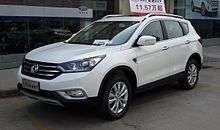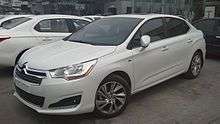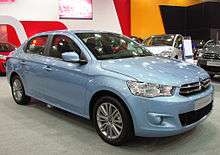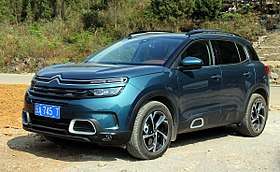Dongfeng Peugeot-Citroën
 | |||||
| joint venture | |||||
| Industry | Automotive | ||||
| Founded | 1992 | ||||
| Headquarters | Wuhan, China | ||||
| Products | Automobiles | ||||
| Brands |
| ||||
| Revenue |
| ||||
|
| |||||
| Total assets |
| ||||
| Total equity |
| ||||
| Owner |
| ||||
| Website |
www | ||||
|
Footnotes / references figures obtained from Dongfeng Motor Group's annual report; DPCA's annual report was not disclosed[1] | |||||
| Dongfeng Peugeot-Citroën Automobile Co., Ltd. | |||||||
| Simplified Chinese | 神龙汽车有限公司 | ||||||
|---|---|---|---|---|---|---|---|
| Traditional Chinese | 神龍汽車有限公司 | ||||||
| Literal meaning | Divine Dragon Automobile Limited Company | ||||||
| |||||||
| Dongfeng Citroën | |||||||
| Simplified Chinese | 东风雪铁龙 | ||||||
| |||||||
| Dongfeng Peugeot | |||||||
| Simplified Chinese | 东风标致 | ||||||
| |||||||





Dongfeng Peugeot-Citroën Automobile Co., Ltd.[3] (DPCA) is a joint venture between Dongfeng Motor Group and PSA Peugeot Citroën. Based in Wuhan, capital of Hubei province, it manufactures Peugeot and Citroën models for sale in China.[3]
Its cars are well liked by consumers, and the Citroën brand received one of the highest scores in a 2014 customer satisfaction survey done by JD Power in China.[4]
Not all PSA Peugeot Citroën products available in China are sold through or manufactured by its joint venture with Dongfeng, and DS Automobiles models especially may be the domain of the French company's other China venture, Changan PSA with Changan Automobile.[5]
DPCA also produces Dongfeng Fengshen-branded consumer vehicles in the same factories that manufacture the PSA models these private label cars are based on.[6]
The company has CSR efforts that include education sponsorship.[7][8]
History
The Peugeot and Citroën brands separately tried to enter the China market in the 1980s. Citroën sold the CX model in 1984, and it even appeared in a Chinese film.[9][10] At the time, Citroën was competing with Volkswagen for the "large car" contract with SAIC Motor, and Volkswagen won, investing $2 Billion in the China market from 1984 to 1998.[11] Peugeot also saw lackluster results.[12] In 1985, it established a joint venture with the government of Guangzhou, Guangzhou Peugeot Automobile Company,[12] which built the 1968 model Peugeot 504 and was defunct by 1997.[3]
The current Dongfeng Peugeot-Citroën comes from a second chance at market entrance for Citroën provided by 'Second Auto Works' (Dongfeng), in 1992.[13] Realizing it lacked a consumer product line, state-owned vehicle maker Dongfeng Motor Corporation initially approached Toyota in the hopes of establishing a joint venture but was rebuffed leading to the same offer being afforded Citroën.[14] Talks were reported to have taken place in Paris as early as the last 1980s with agreement reached in 1990.[15] However, the project was delayed by two years due to French government resistance following the Tiananmen Square massacre, and it only came off the ground in 1992.[14] Initially referred to as Dongfeng Citroën Automobile Company (DCAC), this joint venture company situated itself in Wuhan.[15] Its first product was a hatchback built from semi-complete knock-down kits, the ZX Fukang,[3] and by 1996 production capacity had reached 150,000 units/year with a second offering, the Fukang 988 sedan, being added in 1998.[3] The project may not have seen great success due to a limited product line and delays from the beginning.[14] In addition, early reliance on Shanghai's industrial base (and with it stretched supply chains) for locally sourced parts may have proved a hindrance; at the very least to the development of Wuhan's own industrial cluster.[15] As of 1997, DCAC counted amount its component suppliers 80% more Shanghai firms than those based in Wuhan, and in the early 2000s easily 50% of locally sourced parts continued to come from Shanghai.[15]
In 2002, the first Peugeot-branded product was introduced and the JV was renamed Dongfeng Peugeot-Citroën Automobile (DPCA).[3] That same year saw the joint venture held with equal equity between its French and Chinese parents,[15] but it wasn't until 2004 that Chinese and French banks relaxed their grip on the firm and true 50% ownership stakes were each taken by Dongfeng and PSA Peugeot Citroën.[3]
While most current offerings are versions of cars available in other markets, some vehicles have been tailored to better suit local demand such as changing hatchbacks to three-box designs.[16] At least one car, sold under the name Citroën C2,[3] appears to have been reworked extensively; confusingly the Chinese version C2 seems to have been a rebadged Peugeot model—not the "actual" Citroën C2.
Operations
Production bases and facilities
As of 2010, the joint venture has three production bases—all in Hubei province.[3] A fourth was set to become operational c. 2016 in Chengdu, Sichuan province, increasing production capacity by 300,000 units per year.[17] With the completion of this factory, total yearly production capacity will approach one million whole vehicles.[6]
A Xiangyang production base makes engines with capacity in excess of one million, yearly, and has been operational since 1996.[6]
PSA Peugeot Citroën has two facilities in Shanghai—an R&D center (the China Tech Center) and a design center.[18]
Dealer network
Its dealer network boasts nearly 300 Citroën shops in over 200 Chinese cities and about 170[18] Peugeot showrooms (other sales and service stores that carry and cater to Peugeots do exist).[3] As of 2010, imported models are also sold although by a separate, wholly PSA-owned subsidiary, Peugeot Citroën (China) Automotive Trade Co Ltd.[3] It's possible the situation has changed as of 2015 since in that year PSA Peugeot Citroën signed an agreement with Dongfeng to sell some imports.[19]
The Citroën DS5, Citroën DS 5LS and DS 6WR models are built and sold in China by Citroën DS/PSA, but these are by another joint venture, Changan PSA, established in 2010.[20]
Ownership
Ownership of the joint venture has evolved since its establishment in 1992. In 2000, ownership was: 31%, Dongfeng Motor Corporation; 39%, Chinese banks; 26.9%, PSA Peugeot Citroën; 3.1%, international banks. In 2002, both Dongfeng and PSA Peugeot Citroën took equal 32% shares, and by 2004 they had bought out the remaining equity stakes held by banks resulting in each vehicle-maker holding 50% ownership of the joint venture.[3] After the IPO, the stake held by Dongfeng Motor Corporation was transferred to Dongfeng Motor Group.
In a rare move for the industry, 2014 saw Dongfeng Motor Group take a 14% stake in the then-ailing PSA Peugeot Citroën, a parent company of DPCA.[21]
Sales figures
| Year | Vehicle sales |
|---|---|
| 1996 | 7,200 |
| 1997 | 28,000 |
| 1998 | 33,400[22] |
| 1999 | 44,300[22] |
| 2000 | 52,000[22] |
| 2001 | 53,200[22] |
| 2002 | 85,100[22] |
| 2003 | 103,100[22] |
| 2004 | 89,100[23][22] |
| 2005 | 140,400[23][22] |
| 2006 | 201,318[23] |
| 2007 | 207,500[23] |
| 2008 | 189,162[23] |
| 2009 | 272,000[23] |
| 2010 | 376,000[23] |
| 2011 | 404,437[6] |
| 2012 | 436,500[note 1] |
| 2013 | 550,500[note 1] |
| 2014 | 734,000[note 1] 719,000[6] |
Footnote
- 1 2 3 2012-2014 sales figures may conflate DPCA figures with those of PSA's other China JV, Changan PSA, which had a 200,000 units/year production capacity as of 2015. "PSA Peugeot Citroën in China (a PSA Press Kit)". groupe-psa.com. PSA Peugeot Citroën. April 2015.
References
- ↑ "2016 Annual Report" (PDF). Dongfeng Motor Group. 27 April 2017. pp. 154–155. Retrieved 28 July 2017.
- ↑ "PSA launches Citroën C3-XR, 4th Chinese-built SUV". Automotive News. November 25, 2014. Retrieved 2014-12-06.
- 1 2 3 4 5 6 7 8 9 10 11 12 China Division: PSA Peugeot Citroën in China; NEWS KIT (PDF), PSA Peugeot Citroën, April 2010, archived from the original (PDF) on 2010-12-07
- ↑ "Dongfeng Citroen tie for top score in China satisfaction survey". Automotive News. 2014-07-18. Retrieved 2014-11-10.
Dongfeng Citroen received the highest numerical score in a tie among auto manufacturers in mass market of the J.D. Power Asia Pacific 2014 China Sales Satisfaction Index (SSI) StudySM.
- ↑ "UPDATE 1-PSA JV says on schedule to sell DS cars in China". reuters.com. Thomson Reuters. 16 February 2012.
- 1 2 3 4 5 "PSA Peugeot Citroën in China (a PSA Press Kit)". groupe-psa.com. PSA Peugeot Citroën. April 2015.
- ↑ "Construction sponsored by Citroen on a primary school in Guangxi Zhuang and the beginning of the 2012 Citroen Red Crayon Campaign". China Daily. 2012-11-19. Retrieved 2014-12-07.
- ↑ "PSA Peugeot Citroën University initiates 23 partnerships". PSA Peugeot Citroën. 2011-09-30. Archived from the original on 2014-12-09. Retrieved 2014-12-07.
the Group has signed a letter of intent with Tongji University in Shanghai
- ↑ "Fei cui ma jiang, 1987 Movie". Retrieved 7 July 2017.
- ↑ Guo Yu Gang (4 July 2016). "French Car in China" (in Chinese). The Confucius Institute. Retrieved 7 July 2017.
- ↑ Webb, Alysha (20 February 2006). "A whole new world: The rise, fall and rebound of Europe's carmakers in China". Automotive News Europe. Crain Communications. Retrieved 12 April 2016.
- 1 2 Fernandez, Juan Antonio; Liu, Shengjun (2007), China CEO: a case guide for business leaders in China, Singapore: John Wiley and Sons, p. 78, ISBN 978-0-470-82224-1
- ↑ Walter Arnold (November 2003). "The Japanese Automobile Industry in China". JPRI Working Paper No. 95. Japan Policy Research Institute. Retrieved 7 July 2017.
- 1 2 3 Komura, Chikara (2000). Hamada, Kōichi; Matsushita, Mitsuo; Kōmura, Chikara, eds. "Comments on "Automobile Industrial Policy and WTO Agreements: China and Taiwan", presented by Cheng-Cherng Chen". Dreams and Dilemmas: Economic Friction and Dispute Resolution in the Asia-Pacific. Singapore: Seikei University Center for Asian and Pacific Studies, Japan: 167. ISBN 981-230-069-4.
- 1 2 3 4 5 Thun, Eric (2006). Changing lanes in China: foreign direct investment, local government, and auto sector development (illustrated ed.). Cambridge University Press. pp. 174–175. ISBN 978-0-521-84382-9.
- ↑ Åhman, Michael, ed. (1999). Bilkatalogen 2000 (Swedish edition of German Auto Katalog) (in Swedish). Solna, Sweden: Auto Motor & Sport Sverige AB. p. 149.
- ↑ Laurence Frost and Gilles Guillaume (2 July 2014). "UPDATE 1-Fourth Peugeot-Dongfeng China plant gets green light". reuters.com. Thompson Reuters. Retrieved 1 March 2015.
- 1 2 Peugeot sees China driving its brand chinadaily.com.cn, 2010-10-29
- ↑ "Dongfeng-PSA to sell imported vehicles in 2015 in China". Automotive news. November 19, 2014. Retrieved 2014-12-07.
- ↑ CAPSA – Chang’an-PSA’s new joint venture company chinacartimes.com, June 15, 2011
- ↑ "Peugeot signs Dongfeng deal, recovery hurdles remain". Reuters. 26 March 2014. Retrieved 1 December 2014.
- 1 2 3 4 5 6 7 8 Dossier de presse PSA (1996-2005) (PDF) (in French). PSA Peugeot Citroën. March 2006. Archived 2011-08-07 at the Wayback Machine.
- 1 2 3 4 5 6 7 "Dossier de presse Chine - avril 2011" (PDF) (in French). PSA Peugeot Citroën. 18 April 2011. Archived from the original (PDF) on 5 July 2011. Retrieved 3 June 2011.
.jpg)
